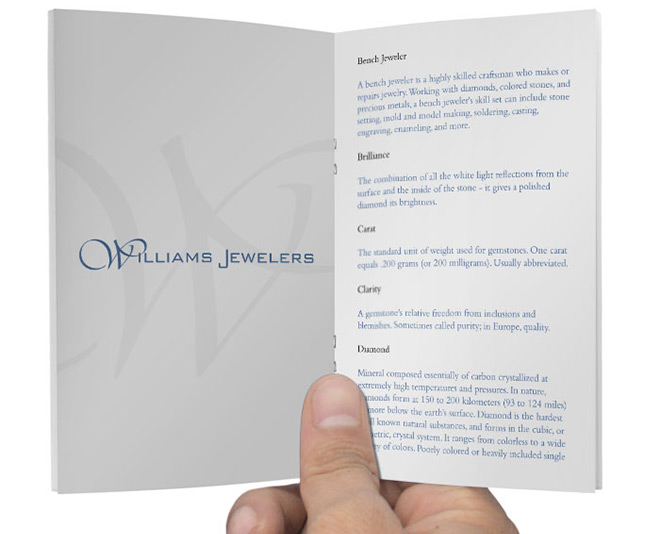Glossary

Glossary of Jewelers Terms
Bench Jeweler
A bench jeweler is a highly skilled craftsman who makes or repairs jewelry. Working with diamonds, colored stones, and precious metals, a bench jeweler's skill set can include stone setting, mold and model making, soldering, casting, engraving, enameling, and more.
Brilliance
The combination of all the white light reflections from the surface and the inside of the stone - it gives a polished diamond its brightness.
Carat
The standard unit of weight used for gemstones. One carat equals .200 grams (or 200 milligrams). Usually abbreviated.
Clarity
A gemstone's relative freedom from inclusions and blemishes. Sometimes called purity; in Europe, quality.
Diamond
Mineral composed essentially of carbon crystallized at extremely high temperatures and pressures. In nature, diamonds form at 150 to 200 kilometers (93 to 124 miles) or more below the earth's surface. Diamond is the hardest of all known natural substances, and forms in the cubic, or isometric, crystal system. It ranges from colorless to a wide variety of colors. Poorly colored or heavily included single crystals are used for industrial purposes.
Dispersion
Sometimes called "fire," dispersion is the breaking up of white light into spectral hues and the "rainbow" colors you see when light passes through a prism. Diamonds are more dispersive than most other gems.
Fancy Colored
Any naturally colored diamond with a noticeable depth of bodycolor considered to be rare or attractive. Red and green are the rarest fancy colors, followed by purple, violet, orange, blue, and pink. Yellow and greenish yellow diamonds are more common. While white, black, and gray are not, strictly speaking, spectral colors, they are also considered fancies. In the GIA color grading system, fancy color grades are described as faint, very light, light, fancy light, fancy, fancy intense, and fancy dark.
Finish
The quality of a diamond's polish, the condition of its girdle, and the precision of the cut.
GIA
Since its beginning in 1931, the nonprofit Gemological Institute of America has helped over a quarter of a million students turn their love of diamonds into careers in gemology, jewelry design and manufacturing. At 11 worldwide campuses and through distance learning, our students earn the credentials that make them the most respected and successful jewelers in the world.
But GIA is more than a school. It is a world-renowned research facility and information center. Its laboratory serves as an independent third party, offering grading and identification services that are the most highly regarded in the gem and jewelry industry.
GIA developed the international diamond grading standard known as the Four Cs. And now, for the first time, we offer our gemological expertise directly to the consumer through this online course. The information contained here is a sample of what our own students learn. We hope you find it useful, informative and fun.
Graduated Gemologist
A GIA Graduate Gemologist (G.G.) has successfully completed GIA's rigorous diploma program which prepares jewelers and gemologists around the world to grade and identify the full range of diamonds and colored stones. A GIA Graduate Gemologist is most often a buyer, appraiser, and senior professional within the gem and jewelry industry.
Metric Carats
The standard unit of weight used for gemstones. One carat equals .200 grams (or 200 milligrams). Usually abbreviated ct.
Optical Properties
Those characteristics of a gemstone which govern its interaction with light.
Points
A point is the unit of weight equal to one one-hundredth of a metric carat (0.01 ct).
Proportions
Proportion refers to the angles and relative measurements of a polished diamond. More than any other feature, proportions determine a diamond's optical properties. Studies have shown that table size, crown angle, and pavilion depth have a dramatic effect on a diamond's appearance.
Reports
A report provides an objective analysis of a diamond’s quality. GIA issues several types of reports. The GIA Diamond Grading Report is available for diamonds of all weights. The Dossier is a special report issued for diamonds weighing less than 1 ct.
Round Brilliant
One of the most popular diamond cuts.
Scintillation
Sometimes called "sparkle," scintillation refers to the tiny flashes of light when the diamond, the light source, or the observer moves. It depends on the number, size, and position of the facets. The quality of the polish affects scintillation, too.
Shape
Shapes other than the standard round brilliant are called fancy shapes or fancy cuts. Their names are based on their shapes. The best known are the heart, marquise, pear-shaped cut, emerald-cut, oval, and radiant.
Symmetry
A grading term for the exactness of shape and placement of facets. Variations in symmetry include off-center culets and tables, poor facet alignment, misshapen facets, out-of-round girdles, and wavy girdles.

